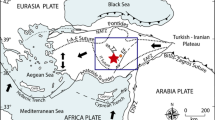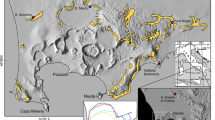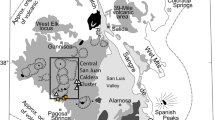Abstract
Constraining magmatic and eruptive processes is key to understanding how volcanoes operate. However, reconstructing eruptive and pre-eruptive processes requires the ability to see through any post-eruptive modification of the deposit. The well-preserved Grey’s Landing ignimbrite from the central Snake River Plain provides an opportunity to systematically investigate the post-eruptive processes occurring through a single deposit sheet. Despite overall compositional homogeneity in both bulk and glass compositions, the Grey’s Landing ignimbrite does preserve differences in the abundance of Li in plagioclase crystals which are strongly associated with the host lithology. Li abundances in plagioclase from the quickly cooled upper and basal vitrophyres are typically low (average 5 ppm, n = 262) while plagioclase from the microcrystalline interior of the deposit has higher Li contents (average 33 ppm, n = 773). Given that no other trace elemental parameter in plagioclase varies, we interpret the variability in Li to reflect a post-depositional process. Groundmass crystallisation of a rhyolite like Grey’s Landing requires ∼50 % crystallisation of sanidine and variable amounts of a silica-rich phase (quartz, tridymite, cristobalite) and plagioclase to satisfy mass balance. We suggest the low affinity of Li for sanidine causes migration of groundmass Li into plagioclase during crystallisation. Even within the microcrystalline interior of the deposit, the morphology of the groundmass varies. The more marginal, finer-grained regions are dominated by cristobalite as the SiO2-rich phase while tridymite and quartz are additionally found in the more slowly cooled, coarser-grained portions of thick sections of the ignimbrite. Numerical models of cooling and crystallisation tested against field observations indicate that the groundmass crystallisation occurred relatively rapidly following emplacement (a maximum of a few years where the ignimbrite is thickest). These numerical models also illustrate that the time at which the potential for rheomorphism ceases (either the ignimbrite is a solid glass, or >50 % crystalline) is diachronous across the deposit.











Similar content being viewed by others
References
Andrews GDM (2006) The emplacement and deformation of high-temperature tuffs: a structural analysis of the Grey’s Landing ignimbrite, Snake River Plain, Idaho. Unpub PhD thesis, Univ Leicester, 337 pages
Andrews GDM, Branney MJ (2011) Emplacement and rheomorphic deformation of a large, lava-like rhyolitic ignimbrite: Grey’s Landing, southern Idaho. Geol Soc Am Bull 123:725–743. doi:10.1130/B30167.1
Andrews GDM, Branney MJ, Bonnichsen B, McCurry M (2008) Rhyolitic ignimbrites in the Rogerson Graben, southern Snake River Plain volcanic province: volcanic stratigraphy, eruption history and basin evolution. Bull Volcanol 70:269–291. doi:10.1007/s00445-007-0139-0
Bagdassarov ND, Dingwell DB, Webb SL (1994) Viscoelasticity of crystal- and bubble-bearing rhyolite melts. Phys Ear Plan Inter 83:83–99
Baxter PJ, Bonadonna C, Dupree R, Hards VL, Kohn SC, Murphy MD, Nichols A, Nicholson RA, Norton G, Seal A, Sparks RSJ, Vickers BP (1999) Cristobalite in volcanic Ash of the Soufriere Hills Volcano, Montserrat, British West Indies. Science 283:1142–1145
Berlo K, Blundy J, Turner S, Cashman K, Hawkesworth C, Black S (2004) Geochemical precursors to volcanic activity at Mount St. Helens, USA. Science 306(5699):1167–1169. doi:10.1126/science.1103869
Bindeman IN, Davis AT, Drake MJ (1998) Ion microprobe study of plagioclase-basalt partition experiments at natural concentration levels of trace elements. Geochem Cosmochem Acta 62(7):1175–1193
Bonnichsen B, Leeman WP, Honjo N, McIntosh WC, Godchaux MM (2008) Miocene silicic volcanism in southwestern Idaho: geochronology, geochemistry, and evolution of the central Snake River Plain. Bull Volcanol 70:315–342. doi:10.1007/s00445-007-0141-6
Boroughs S, Wolff JA, Ellis BS, Bonnichsen B, Larson PB (2012) Evaluation of models for the origin of Miocene low-δ18O rhyolites of the Yellowstone/Columbia River Large Igneous Province. Earth Planet Sci Lett 313–314:45–55
Branney MJ, Kokelaar P (1992) A reappraisal of ignimbrite emplacement: progressive aggradation and changes from particulate to non-particulate flow during emplacement of high-grade ignimbrite. Bull Volcanol 54:504–520
Branney MJ, Bonnichsen B, Andrews GDM, Ellis B, Barry TL, McCurry M (2008) ‘Snake River (SR) -type’ volcanism at the yellowstone hotspot track: distinctive products from unusual, high-temperature silicic super-eruptions. Bull Volcanol 70:293–314. doi:10.1007/s00445-007-0140-7
Brueseke ME, Hart WK, Heizler MT (2008) Diverse mid-Miocene silicic volcanism associated with the Yellowstone–Newberry thermal anomaly. Bull Volcanol 70:343–360
Cashman KV, Thornber CR, Pallister JS (2008) From dome to dust: shallow crystallisation and fragmentation of conduit magma during the 2004–2006 dome extrusion of Mt. St. Helens, Washington. US Geol Surv Prof Paper 1750:387–413
Castro JM, Beck P, Tuffen H, Alexander RL, Dingwell DB, Martin C (2008) Timescales of spherulite crystallization in obsidian inferred from water concentration profiles. Am Mineral 93:1816–1822
Castro JM, Cottrell E, Tuffen H, Logan AV, Kelly KA (2009) Spherulite crystallization induces Fe-redox redistribution in silicic melt. Chem Geol 268:272–280
Chapin CE, Lowell GR (1979) Primary and secondary flow structures in ash-flow tuffs of the Gribbles Run paleovalley, central Colorado. In Chapin CE, Elston WE (eds) Ash-flow tuffs. Geol Soc Am Spec Pap 180:137–154
Charlier BLA, Morgan DJ, Wilson CJN, Wooden JL, Allan ASR, Baker JA (2012) Lithium concentration gradients in feldspar and quartz record the final minutes of magma ascent in an explosive supereruption. Earth Plan Sci Lett 319–320:218–227. doi:10.1016/j.epsl.2011.12.016
Coogan LA (2011) Preliminary experimental determination of the partitioning of lithium between plagioclase crystals of different anorthite contents. Lithos 125(1–2):711–715. doi:10.1016/j.lithos.2011.03.016
Cordonnier B, Schmalholz SM, Hess K-U, Dingwell DB (2012) Viscous heating in silicate melts: an experimental and numerical comparison. J Geophys Res 117, B02203. doi:10.1029/2010JB007982
Ellis BS, Barry TL, Branney MJ, Wolff JA, Bindeman I, Wilson R, Bonnichsen B (2010) Petrologic constraints on the development of a large-volume, high temperature, silicic magma system: the Twin Falls eruptive centre, central Snake River Plain. Lithos 120:475–489. doi:10.1016/j.lithos.2010.09.008
Ellis BS, Wolff JA, Boroughs S, Mark DF, Bonnichsen B, Starkel WA (2013) Rhyolitic Volcanism of the central Snake River Plain: a review. Bull Volcanol 75:745. doi:10.1007/s00445-013-0745-y
Gardner JE, Befus KS, Watkins J, Hesse M, Miller N (2012) Compositional gradients surrounding spherulites in obsidian and their relationship to spherulite growth and lava cooling. Bull Volcanol 74:1865–1879
Geist D, Richards MA (1993) Origin of the Columbia plateau and the Snake River Plain: deflection of the Yellowstone plume. Geology 21:789–792
Giordano D, Nichol ARL, Dingwell DB (2005) Glass transition temperatures of natural hydrous melts: a relationship with shear viscosity and implications for the welding process. J Volcanol Geotherm Res 142:105–118
Gottsmann J, Dingwell DB (2001) The cooling of frontal flow ramps: a calorimetric study on the Rocche Rosse rhyolite flow, Lipari, Aeolian Islands, Italy. Terra Nov. 13:157–164. doi:10.1046/j.13653121.2001.00332.x
Gránásy L, Pusztai T, Tegze G, Warren JA, Douglas JF (2005) Growth and form of spherulites. Phys Rev E 72:011605. doi:10.1103/PhysRevE.72.011605
Hildreth W, Wilson CJN (2007) Compositional zoning of the Bishop Tuff. J Petrol 48:951–999. doi:10.1093/petrology/egm007
Horwell CJ, Le Blond JS, Michnowicz SAK, Cressey G (2010) Cristobalite in a rhyolitic lava dome: evolution of ash hazard. Bull Volcanol 72:249–253
Husain T, Elsworth D, Voight B, Mattioli G, Jansma P (2014) Influence of extrusion rate and magma rheology on the growth of lava domes: insights from particle-dynamics modeling. J Volcanol Geotherm Res 285:100–117
Keith HD, Padden FJ (1963) A phenomenological theory of spherulitic crystallization. J App Phys 34:2409. doi:10.1063/1.1702757
Kent AJR, Blundy J, Cashman KV, Donnelly C, Pallister JS, Reagan M, Rowe MC, Thornber CR (2007) Vapor transfer prior to the October 2004 eruption of Mount St. Helens, Washington. Geology 35(3):231–234. doi:10.1130/G22809A.1
Kobberger G, Schmincke HU (1999) Deposition of rheomorphic ignimbrite D (Mogan Formation) Gran Canaria, Canary Islands, Spain. Bull Volcanol 60:465–485
Lavallée Y, Wadsworth FB, Vasseur J, Russell JK, Andrews GDM, Hess K-U, von Aulock FW, Kendrick JE, Tuffen H, Biggin AJ, Dingwell DB (2015) Eruption and emplacement timescales of ignimbrite super-eruptions from thermo-kinetics of glass shards. Front Earth Sci 3:2. doi:10.3389/feart.2015.00002
Liebske C (2015) iSpectra: an open source toolbox for the analysis of spectral images recorded on SEM–EDS systems. Microsc Microanal 21:1006–1016
Mahood G, Hildreth WA (1983) Large partition coefficients for trace elements in high-silica rhyolites. Geochim Cosmochim Acta 47:11–30
Manley CR, Andrews GDM (2004) A numerical modelling investigation of the duration of post-emplacement rheomorphism in a high-grade ignimbrite: Grey’s Landing, Idaho. Geol Soc Am Abs w Prog 36(4):12. doi:10.1371/journal.pone.0044205
Nash WP, Crecraft HR (1985) Partition coefficients for trace elements in silicic magmas. Geochim Cosmochim Acta 49:2309–2322
Perkins ME, Nash BP (2002) Explosive silicic volcanism of the Yellowstone hotspot: the ash fall tuff record. Geol Soc Am Bull 114:367–381
Pick T, Tauxe L (1993) Geomagnetic palaeointensities during the Cretaceous normal superchron measured using submarine basaltic glass. Nature 366:238–242
Robert G, Andrews GDM, Ye J, Whittington AG (2013) Rheological controls on the emplacement of extremely high-grade ignimbrites. Geology 41:1031–1034. doi:10.1130/G34519.1
Romine WL, Whittington AG, Nabelek PI, Hofmeister AM (2012) Thermal diffusivity of rhyolitic glasses and melts: effects of temperature, crystals and dissolved water. Bull Volcanol 74:2273–2287
Ross CS, Smith RL (1955) Water and other volatiles in volcanic glasses. Am Mineral 40(11–2):1071–1089
Rowe MC, Ellis BS, Lindeberg A (2012) Quantifying crystallization and devitrification of rhyolites via X-ray diffraction and electron microprobe analysis. Am Mineral 97(10):1685–1699
Schmincke H-U, Swanson DA (1967) Laminar viscous flowage structures in ash-flow tuffs from Gran Canaria, Canary Islands. J Geol 75:641–664
Smith JV, Brown WL (1988) Feldspar Minerals. Vol. 1, Springer-Verlag, 841 pp
Stevenson RJ, Dingwell DB, Webb SL, Sharp TG (1996) Viscosity of microlite-bearing rhyolitic obsidians: an experimental study. Bull Volcanol 58:298–309
Stevenson RJ, Dingwell DB, Bagdassarov NS, Manley CR (2001) Measurement and implication of “effective” viscosity for rhyolite flow emplacement. Bull Volcanol 63:227–237
Swanson SE (1977) Relation of nucleation and crystal-growth rate to the development of granitic textures. Am Mineral 62:966–978
Szymanowski D (2014) Mineral-scale evolution of voluminous rhyolites of the Heise volcanic field, eastern Snake River Plain, Idaho, USA. MSc thesis, ETH Zürich
Szymanowski D, Ellis BS, Bachmann O, Guillong M, Phillips WM (2015) Bridging basalts and rhyolites in the Yellowstone–Snake River Plain volcanic province: the elusive intermediate step. Earth Plan Sci Lett 415:80–89
Wall KT, Rowe MC, Ellis BS, Schmidt ME, Eccles JD (2014) Determining volcanic eruption styles on Earth and Mars from crystallinity measurements. Nat Comm 5:5090
Watkins J, Manga M, Huber C, Martin M (2009) Diffusion-controlled spherulite growth in obsidian inferred from H2O concentration profiles. Contrib Mineral Petrol 157:163–172
Wilson CJN (2008) Supereruptions and supervolcanoes: processes and products. Elements 4:29–34
Wolff JA, Wright JV (1981) Rheomorphism of welded tuffs. J Volcanol Geotherm Res 10:13–34
Wolff JA, Ramos FC, Hart GL, Patterson JD, Brandon A (2008) Columbia River flood basalts from a centralized crustal magmatic system. Nat Geosci 1:177–180
Zhang Y (2013) Kinetics and dynamics of mass-transfer-controlled mineral and bubble dissolution or growth: a review. Eur J Mineral 25:255–266. doi:10.1127/0935-1221/2013/0025-2292
Acknowledgments
We would like to thank the GeoAnalytical Laboratory at Washington State University for providing first class geochemical data as ever. LA-ICPMS analyses were facilitated by the excellence of Marcel Guillong, and XRD data were collected with the help of Abbie Lindeberg. We appreciate the constructive reviews of Christoph Breitkreutz and an anonymous reviewer as well as the editorial effort from Steve Self. Partial financial support for this project from NSF (USA) EAR-0911457 and HRD-1137774, and SNSF – 200021_155923 (Switzerland) is gratefully acknowledged.
Author information
Authors and Affiliations
Corresponding author
Additional information
Editorial handling: S. Self
Rights and permissions
About this article
Cite this article
Ellis, B.S., Cordonnier, B., Rowe, M.C. et al. Groundmass crystallisation and cooling rates of lava-like ignimbrites: the Grey’s Landing ignimbrite, southern Idaho, USA. Bull Volcanol 77, 87 (2015). https://doi.org/10.1007/s00445-015-0972-5
Received:
Accepted:
Published:
DOI: https://doi.org/10.1007/s00445-015-0972-5




